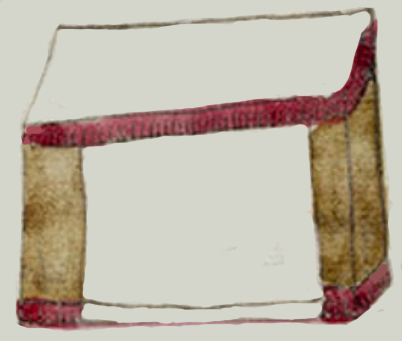frontal (CST29)
This painting of the simplex glyph for the term frontal (a hanging altar cloth) shows a white damask (damasco, using another Spanish loanword here) cloth hanging over the altar table and reaching down to the floor. It is trimmed in red satin table runners (frontaleras in Spanish, another loanword used in the Nahuatl companion text here).
Stephanie Wood
For more on the Codex Sierra, see Kevin Terraciano’s study (2021), especially p. 153, where he translates the relevant Nahuatl text. While damask and satin (raso, another loanword used here) suggest strong European influence, Nahuas did have the ability to spin and weave large pieces of cotton and woolen cloth. Some glyphs from c. 1541, below, provide partial evidence of the range of options.
Stephanie Wood
1550–1564
Jeff Haskett-Wood
frontales, frontalera, iglesia, altares, telas

frontal (a loanword from Spanish taken into Nahuatl), a hanging altar cloth, https://nahuatl.wired-humanities.org/content/frontal
frontal
Stephanie Wood
Códice Sierra-Texupan, plate 29, page dated 1560. Origin: Santa Catalina Texupan, Mixteca Alta, State of Oaxaca. Kevin Terraciano has published an outstanding study of this manuscript (Codex Sierra, 2021), and in his book he refers to alphabetic and “pictorial” writing, not hieroglyphic writing. We are still counting some of the imagery from this source as hieroglyphic writing, but we are also including examples of “iconography” where the images verge on European style illustrations or scenes showing activities. We have this iconography category so that such images can be fruitfully compared with hieroglyphs. Hieroglyphic writing was evolving as a result of the influence of European illustrations, and even alphabetic writing impacted it.
https://bidilaf.buap.mx/objeto.xql?id=48281&busqueda=Texupan&action=search
The Biblioteca Digital Lafragua of the Biblioteca Histórica José María Lafragua in Puebla, Mexico, publishes this Códice Sierra-Texupan, 1550–1564 (62pp., 30.7 x 21.8 cm.), referring to it as being in the “Public Domain.” This image is published here under a Creative Commons license, asking that you cite the Biblioteca Digital Lafragua and this Visual Lexicon of Aztec Hieroglyphs.



